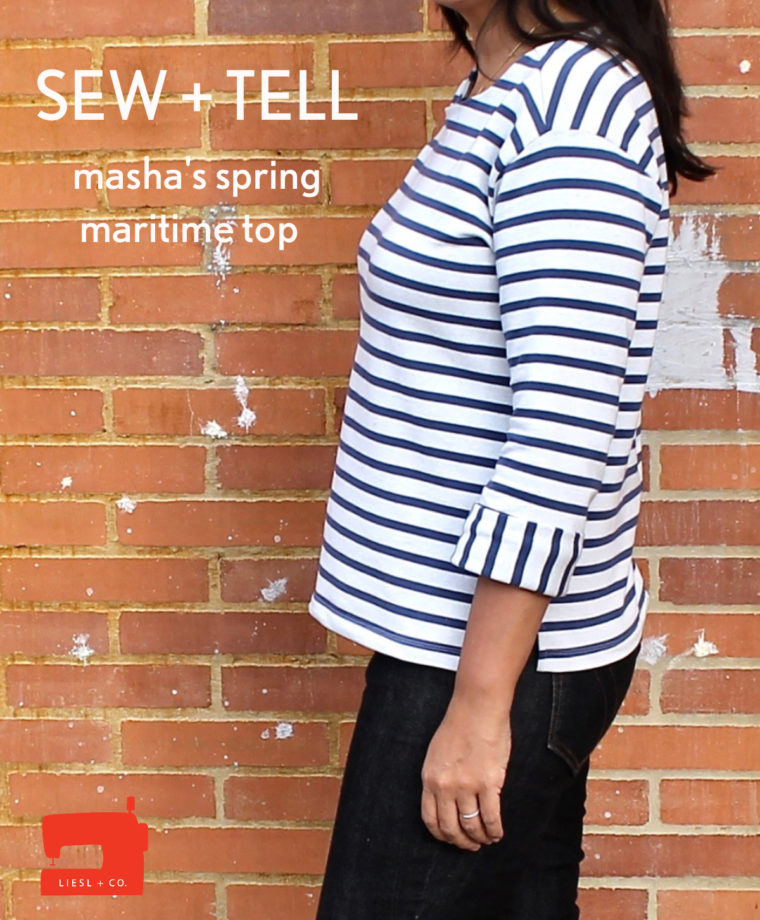Nothing says spring like a striped boat-neck top. The Maritime Top is just the type of garment I want to wear when the crocuses peek out and the breeze begins to feel slightly less biting.
In Bogota, where I lived until recently, the weather is spring-like year-round. As an American East Coast girl, though, I found myself living out the seasons vicariously through my Instagram feed. The winter-to-spring transition is my favorite one, so I felt like sewing something to celebrate, notwithstanding the fact that there was no transition at 8770 feet in the Andes Mountains.

This was my first time making the Maritime Top. I had found a 40″ remnant of cotton French terry at a local shop and the fabric was exceptionally clear about its preferred destiny.
First things first: I needed to choose my size. With a 36″ high bust, I’m an 8 shoulder in Liesl + Co. patterns (see here for more in-depth information about choosing your size). My full bust is 40″, so an FBA was in order. I did not want to add a dart, though I could have; the French terry fabric is fairly stable and it would have worked out just fine.
I decided to use a pivot-and-slide bust adjustment, which adds width without a dart. The classic pivot-and-slide is adjusted at the end so as not to enlarge the hip measurement. However, my waist and hips are a size 12, so I adapted the adjustment a bit to keep the extra width there. You can see how I did it in our tutorial. The adjustment produced a very pleasing fit for me: fitted enough in the bust, but boxy below it.
I also did a 5/8″ high round back adjustment (see a tutorial for this adjustment here) and a 3/8″ low round back adjustment, for a total of 1″ length added in the back. This adjustment adds a center seam to the back of the top, but the improvement in fit is worth it.
Finally, I also did a 1/2″ forward shoulder adjustment.
Thanks to the dropped shoulder, the Maritime has a relaxed sleeve fit. This meant that no full bicep adjustment was needed, which is extremely rare for me. (If you are wondering how to do a full bicep adjustment, please check out Liesl’s tutorial here.)

I made one change to the pattern, and that was to add a sleeve cuff to the long-sleeved view. I didn’t shorten the sleeve at all, but added a 5″ cuff to the bottom by cutting two 10″ long pieces whose width equaled the circumference of the sleeve opening.
I sewed the long ends of each piece of fabric together, right sides together, to make a tube. Then I sewed one end of the cuff to the sleeve bottom, right sides together. I folded the cuff in half, turning the raw edges under to cover the stitching line on the inside of the cuff. I used my coverstitch machine to topstitch the cuff in place. Â I can wear the cuff folded (see photo above) or unfolded (see photo below) depending on how warm I want my lower arms to be.
Other than the cuff addition, I sewed up the pattern as directed. I did tack down the neckline facings by machine at the shoulder seams, and by hand at center front and back, as it wanted to flip out.

This top has been in regular rotation since I finished it in early January. Have you made this pattern yet? Nothing says spring like the Maritime Top!
(adsbygoogle = window.adsbygoogle || []).push({}); Â
Dewalt Boots,Carhartt Work Boots,Carolina Work Boots,Slip On Work Boots
Huaying Shoes Co. Ltd , https://www.hya3shoes.com